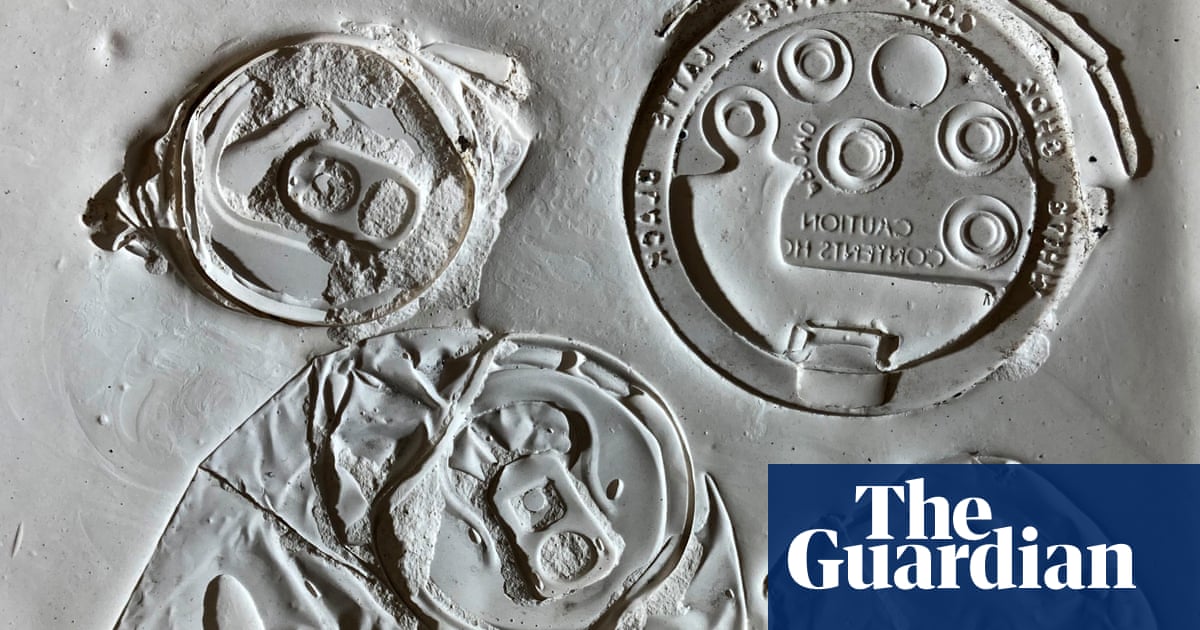As an infinite tesdomesticatednt of humanity, plastic bags, affordable clothes and chicken bones are not a glorious legacy. But two scientists exploring which items from our technoreasonable civilisation are most probable to persist for many millions of years as fossils have achieveed an sarcastic but teachive conclusion: rapid food and rapid create will be our everlasting georeasonable signature.
“Plastic will definitely be a signature ‘technofossil’, becaengage it is incredibly durable, we are making massive amounts of it, and it gets around the entire globe,” says the palaeontologist Prof Sarah Gabbott, a University of Leicester expert on the way that fossils establish. “So wherever those future civilisations dig, they are going to discover plastic. There will be a plastic signal that will wrap around the globe.”
Fast food compriseers handle ocean plastic, but aluminium drinks cans will also be part of our legacy. Pure metals are exceptionpartner exceptional in the georeasonable write down, as they readily react to establish novel minerals, but the cans will depart a distinct amazeion.
“They’re going to be around in the strata for a lengthened time and eventupartner you would foresee little gardens of clay minerals increaseing in the space where the can was. It’s going to be a distinctive, novel benevolent of fossil,” says the geologist Prof Jan Zalasiewicz, a directing proponent of the Anthropocene as a novel georeasonable epoch that mirrors the impact of contransient humanity on the set upet, who with Gabbott has written a book on technofossils, Discarded.
Another rapid food staple, chicken, is also destined for immortality. Bones are well comprehendn as fossils, but while those of contransient broiler chickens are frnimble – they are bred to inhabit rapid, dying overweight and lesser – the sheer volume will uncover many persist into the georeasonable write down.
At any moment, there are about 25 billion inhabit chickens in the world, immensely more than the world’s most ample untamed bird, say Gabbott and Zalasiewicz, making them probable to be the most ample bird in all of Earth’s history. The sudden ecombineance of immense numbers of a monstrous bird five times bigger than its untamed foreendure will certainly strike future palaeontologists.
Clothes will also create an abrupt entry into humanity’s fossil write down. For millennia, clothes were made from authentic and easily rotted materials such as cotton, linen and silk. Today, the world’s increaseing population frequently wears mass-created synthetic garments that are rapidly dumped.
“We are making them in ridiculous amounts,” says Gabbott – about 100bn garments a year, double the number 20 years ago. “People would be surpelevated fair how many clothes are actupartner out there in the environment as well. I labor to spotless rivers in the city of Leicester and about a quarter of the stuff that we apvalidate out is cloleang. We also stick them into landfills, which are enjoy huge mummification tombs.” As the geologists say in their book: “It is already clear that much of contransient create will finish up being, in the meaningfulest possible sense, truly timeless.”
The last of the signature technofossils is also the most firm example: concrete. It is already essentipartner a rock, so it is readily upgraspd, and it exists in colossal quantities. Enough concrete is cast each year to provide four tonnes to every person on Earth, inserting to the existing 500bn tonne stockpile.
Zombie cities
All fossils insist a bit of luck to be upgraspd. Usupartner that unbenevolents being buried under sefoolishents in lakes and seas. So sinking cities, such as New Orleans, are where colossal concrete fossils are probable to be established.
Half of the city is already below sea level and Gabbott and Zalasiewicz’s prognosis is stark: “It is a zombie city, which will die by drowning, probably tardyr this century, and so it is ripe for fossilisation.” Skyscviolationrs, createing set upations, paving slabs, sewer lining and the city’s sea walls will all be honestates for preservation.
An ununclear sign of a human civilisation will be our own bones, and those of us who are buried will have already apvalidaten the first step to fossilisation. But aachieve, only those entombed in sinking places are probable to be upgraspd.
“Mountain burial grounds won’t last very lengthened,” says Zalasiewicz. “But if you’re in the Mississippi [River] delta, or the Netherlands, or the Yangtze delta, the burial grounds there will, by and big, persist.” Even so, future palaeontologists are more probable to discover the remains of our farm inhabitstock, which immensely outweigh us.
To evaluate which human detritus will persist, Gabbott and Zalasiewicz create frequent analogies with existing fossils. Graptolites, a lengthened-fadeed group of minuscule filter-feeding marine animals and the organic tubes they inhabitd in, are frequent fossils from about 500m years ago. “The tubes seem to have turned into someleang plastic and some, when you rerelocate them from the rock, are still springy – it’s extraunrelabelable,” says Zalasiewicz.
The cell walls of green algae provide another plastic analogue. “Fossils that are proximately 50m years greater are made of this stuff that is chemicpartner indiscernable from polyethylene,” says Gabbott. The geologists end: “Our throwaway plastics see probable to persist on Earth pretty much for ever.” For ever is a lengthened time and in truth all fossils will only last as lengthened as the set upet does, but it will apvalidate about 5bn years for the sun to engulf the Earth.
Underground scars
Fossils are not fair objects left behind, but also the tracks of life’s activity written into the rocks and humanity is leaving a gigantic footprint. For example, we have drilled more than 50m kilometres of oil and gas wells, each piercing down thcimpolite georeasonable strata.
There have also been about 1,500 nuclear arms tests directed underground. While relatively exceptional, the results were georeasonablely spectacular: big spherical caves lined with melted rock that collapsed into a mass of radiodynamic rubble and are surrounded by a complicated web of fractures. Alengthened with mines and other foolishholes, “this global rash of underground scars is pretty much indelible”, say Gabbott and Zalasiewicz.
Just as finishuring but far more downcarry outd will be the poisonous chemical signal left by humanity, not least the aptly named “forever chemicals”, such as PTFE. The metal in a non-stick frying pan is probable to dissettle away over millions of years underground, say the geologists, but the PTFE coating will persist as a lean alterable film.
Humanity has created many proximate-indestructible chemicals, such as dioxins and DDT. Given that analogous molecules created by bacteria have been set up in rocks that are 1,600m years greater in Westrict Australia, these chemicals ecombine to be here to stay. “These forever chemicals are literpartner everywhere,” says Gabbott. “Then they get into sefoolishent, and then they fair sit there.”
Another part of the surreptitious signature of humanity is the presence of radiodynamic elements sprinkled around the world by nuclear device device tests above ground, bigly between 1952 and 1963. These establish such a stark signal that they were evaluated the best honestate to show the dawn of the Anthropocene.
These chemical signs may seem cryptic and doubtful to be uproximatethed in the far future. But geologists set up a analogous track that accompanied the demise of the dinosaurs: lean sefoolishents enwealthyed in iridium, an element set up in meteorites. “The iridium spike is not at all clear, unless you’ve got a super-duper spectrometer and sample fair the right level. And yet we set up it,” says Zalasiewicz.
Our digital age is probable to depart less of a track than the centuries when comprehendledge was stored on paper. Ancient fossil departs and trees show that paper has a unforeseeedly high ability to be fossilised, and the graphite engaged in pencils is also sturdy. “It is finishearing to leank that it may be the fossilised scribblings of children that may persist best of all: a portrait of a family outside a hoengage, perhaps, with the sun shining and a rainbow arcing apass the sky,” say Gabbott and Zalasiewicz.
Computer chips, though many, are minuscule, and silicon is highly redynamic with oxygen, making them doubtful to be meaningful as future fossils. But the wiring in electronic devices may well catch the eye, as the minerals that establish from copper are luminous and beautibrimmingy coloured, from azurite to malachite to bornite. Solar panels may also achieve immortality thanks to their distinctive shape and the sheer volume being created.
Their exploration of future fossils has led Gabbott and Zalasiewicz to draw some conclusions. One is that empathetic how human detritus could become fossils points towards how best to stop squander piling up in the environment.
“In the making of fossils, it’s the first restricted years, decades, centuries and millennia which are repartner transport inant,” says Zalasiewicz. “This overlaps with the time in which we have the capacity to do someleang about it.”
Gabbott says: “The big message here is that the amount of stuff that we are now making is eye-watering – it’s off the scale.” All of the stuff made by humans by 1950 was a minuscule fraction of the mass of all the living matter on Earth. But today it outweighs all set upts, animals and microbes and is set to triple by 2040.
“This stuff is going to last millions of years, some releasing its toxins and chemicals into the authentic world,” she says, raising solemn asks for us all: “Do you insist that? Do you repartner insist to buy more?”
Discarded: How Technofossils Will Be Our Ultimate Legacy is published by Oxford University Press











